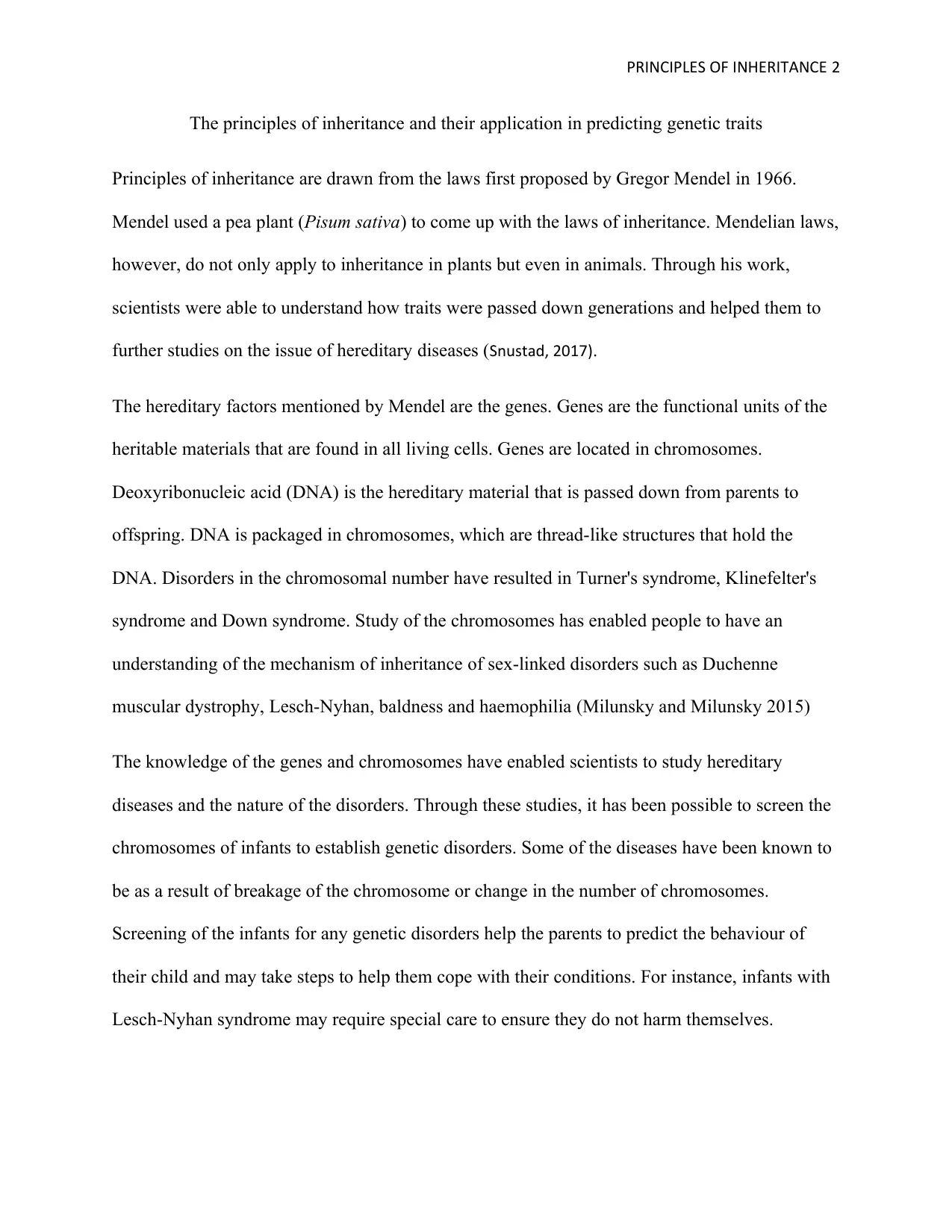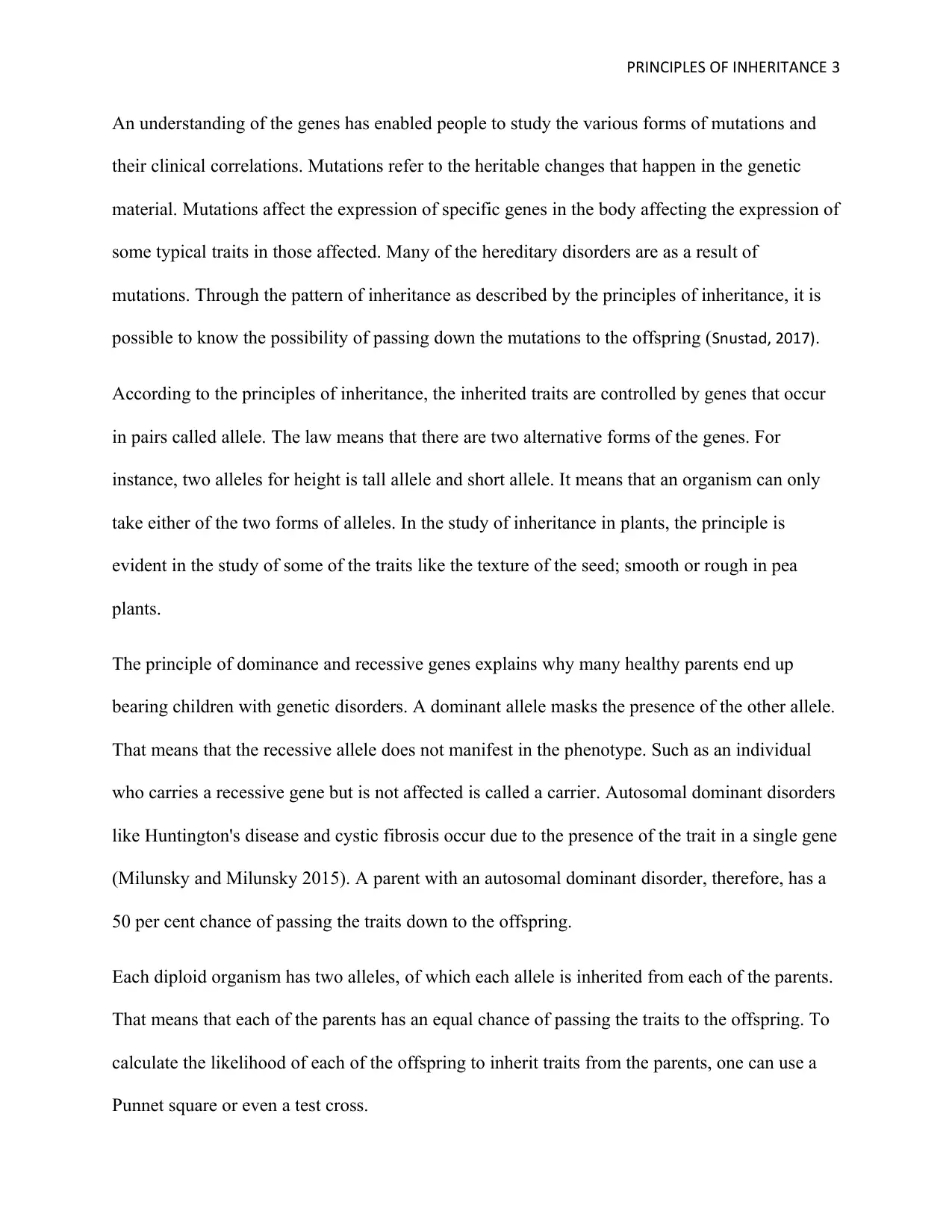Principles of Inheritance: Predicting Genetic Traits and Application
VerifiedAdded on 2023/04/03
|5
|817
|362
Essay
AI Summary
This essay delves into the principles of inheritance, drawing from Gregor Mendel's laws, to explain how genetic traits are passed down through generations. It highlights the significance of genes and chromosomes in understanding hereditary diseases, including chromosomal disorders like Turner's syndrome and sex-linked disorders such as Duchenne muscular dystrophy. The essay further explores the role of mutations in genetic disorders and explains concepts like alleles, dominant and recessive genes, and autosomal dominant disorders. It also discusses Mendel's law of segregation and how genetic testing and Punnett squares are used to predict the likelihood of offspring inheriting specific traits or disorders, emphasizing the importance of understanding genetic inheritance in predicting traits based on family history. Desklib provides access to this and many other solved assignments.

PRINCIPLES OF INHERITANCE 1
Principles of inheritance
Name
Institution
Course
Date
Principles of inheritance
Name
Institution
Course
Date
Paraphrase This Document
Need a fresh take? Get an instant paraphrase of this document with our AI Paraphraser

PRINCIPLES OF INHERITANCE 2
The principles of inheritance and their application in predicting genetic traits
Principles of inheritance are drawn from the laws first proposed by Gregor Mendel in 1966.
Mendel used a pea plant (Pisum sativa) to come up with the laws of inheritance. Mendelian laws,
however, do not only apply to inheritance in plants but even in animals. Through his work,
scientists were able to understand how traits were passed down generations and helped them to
further studies on the issue of hereditary diseases (Snustad, 2017).
The hereditary factors mentioned by Mendel are the genes. Genes are the functional units of the
heritable materials that are found in all living cells. Genes are located in chromosomes.
Deoxyribonucleic acid (DNA) is the hereditary material that is passed down from parents to
offspring. DNA is packaged in chromosomes, which are thread-like structures that hold the
DNA. Disorders in the chromosomal number have resulted in Turner's syndrome, Klinefelter's
syndrome and Down syndrome. Study of the chromosomes has enabled people to have an
understanding of the mechanism of inheritance of sex-linked disorders such as Duchenne
muscular dystrophy, Lesch-Nyhan, baldness and haemophilia (Milunsky and Milunsky 2015)
The knowledge of the genes and chromosomes have enabled scientists to study hereditary
diseases and the nature of the disorders. Through these studies, it has been possible to screen the
chromosomes of infants to establish genetic disorders. Some of the diseases have been known to
be as a result of breakage of the chromosome or change in the number of chromosomes.
Screening of the infants for any genetic disorders help the parents to predict the behaviour of
their child and may take steps to help them cope with their conditions. For instance, infants with
Lesch-Nyhan syndrome may require special care to ensure they do not harm themselves.
The principles of inheritance and their application in predicting genetic traits
Principles of inheritance are drawn from the laws first proposed by Gregor Mendel in 1966.
Mendel used a pea plant (Pisum sativa) to come up with the laws of inheritance. Mendelian laws,
however, do not only apply to inheritance in plants but even in animals. Through his work,
scientists were able to understand how traits were passed down generations and helped them to
further studies on the issue of hereditary diseases (Snustad, 2017).
The hereditary factors mentioned by Mendel are the genes. Genes are the functional units of the
heritable materials that are found in all living cells. Genes are located in chromosomes.
Deoxyribonucleic acid (DNA) is the hereditary material that is passed down from parents to
offspring. DNA is packaged in chromosomes, which are thread-like structures that hold the
DNA. Disorders in the chromosomal number have resulted in Turner's syndrome, Klinefelter's
syndrome and Down syndrome. Study of the chromosomes has enabled people to have an
understanding of the mechanism of inheritance of sex-linked disorders such as Duchenne
muscular dystrophy, Lesch-Nyhan, baldness and haemophilia (Milunsky and Milunsky 2015)
The knowledge of the genes and chromosomes have enabled scientists to study hereditary
diseases and the nature of the disorders. Through these studies, it has been possible to screen the
chromosomes of infants to establish genetic disorders. Some of the diseases have been known to
be as a result of breakage of the chromosome or change in the number of chromosomes.
Screening of the infants for any genetic disorders help the parents to predict the behaviour of
their child and may take steps to help them cope with their conditions. For instance, infants with
Lesch-Nyhan syndrome may require special care to ensure they do not harm themselves.

PRINCIPLES OF INHERITANCE 3
An understanding of the genes has enabled people to study the various forms of mutations and
their clinical correlations. Mutations refer to the heritable changes that happen in the genetic
material. Mutations affect the expression of specific genes in the body affecting the expression of
some typical traits in those affected. Many of the hereditary disorders are as a result of
mutations. Through the pattern of inheritance as described by the principles of inheritance, it is
possible to know the possibility of passing down the mutations to the offspring (Snustad, 2017).
According to the principles of inheritance, the inherited traits are controlled by genes that occur
in pairs called allele. The law means that there are two alternative forms of the genes. For
instance, two alleles for height is tall allele and short allele. It means that an organism can only
take either of the two forms of alleles. In the study of inheritance in plants, the principle is
evident in the study of some of the traits like the texture of the seed; smooth or rough in pea
plants.
The principle of dominance and recessive genes explains why many healthy parents end up
bearing children with genetic disorders. A dominant allele masks the presence of the other allele.
That means that the recessive allele does not manifest in the phenotype. Such as an individual
who carries a recessive gene but is not affected is called a carrier. Autosomal dominant disorders
like Huntington's disease and cystic fibrosis occur due to the presence of the trait in a single gene
(Milunsky and Milunsky 2015). A parent with an autosomal dominant disorder, therefore, has a
50 per cent chance of passing the traits down to the offspring.
Each diploid organism has two alleles, of which each allele is inherited from each of the parents.
That means that each of the parents has an equal chance of passing the traits to the offspring. To
calculate the likelihood of each of the offspring to inherit traits from the parents, one can use a
Punnet square or even a test cross.
An understanding of the genes has enabled people to study the various forms of mutations and
their clinical correlations. Mutations refer to the heritable changes that happen in the genetic
material. Mutations affect the expression of specific genes in the body affecting the expression of
some typical traits in those affected. Many of the hereditary disorders are as a result of
mutations. Through the pattern of inheritance as described by the principles of inheritance, it is
possible to know the possibility of passing down the mutations to the offspring (Snustad, 2017).
According to the principles of inheritance, the inherited traits are controlled by genes that occur
in pairs called allele. The law means that there are two alternative forms of the genes. For
instance, two alleles for height is tall allele and short allele. It means that an organism can only
take either of the two forms of alleles. In the study of inheritance in plants, the principle is
evident in the study of some of the traits like the texture of the seed; smooth or rough in pea
plants.
The principle of dominance and recessive genes explains why many healthy parents end up
bearing children with genetic disorders. A dominant allele masks the presence of the other allele.
That means that the recessive allele does not manifest in the phenotype. Such as an individual
who carries a recessive gene but is not affected is called a carrier. Autosomal dominant disorders
like Huntington's disease and cystic fibrosis occur due to the presence of the trait in a single gene
(Milunsky and Milunsky 2015). A parent with an autosomal dominant disorder, therefore, has a
50 per cent chance of passing the traits down to the offspring.
Each diploid organism has two alleles, of which each allele is inherited from each of the parents.
That means that each of the parents has an equal chance of passing the traits to the offspring. To
calculate the likelihood of each of the offspring to inherit traits from the parents, one can use a
Punnet square or even a test cross.
⊘ This is a preview!⊘
Do you want full access?
Subscribe today to unlock all pages.

Trusted by 1+ million students worldwide

PRINCIPLES OF INHERITANCE 4
Mendel's law of segregation says that each pair of alleles separate during meiosis. Diploid
organisms have two pairs of genes. During meiosis, the alleles are halved to become haploid.
That allows the zygote to acquire each of the haploid numbers of alleles from each of the parents
to have a diploid number of alleles (Milunsky and Milunsky 2015).
In conclusion, the knowledge of inheritance has made it possible to understand the patterns of
inheritance and nature of hereditary disorders. Genetic testing has made it possible to predict the
likelihood of parents passing down a genetic disorder to their offspring. Understanding principles
of genetic inheritance has, therefore, played a significant role in predicting the traits of the
offspring based on family history.
Mendel's law of segregation says that each pair of alleles separate during meiosis. Diploid
organisms have two pairs of genes. During meiosis, the alleles are halved to become haploid.
That allows the zygote to acquire each of the haploid numbers of alleles from each of the parents
to have a diploid number of alleles (Milunsky and Milunsky 2015).
In conclusion, the knowledge of inheritance has made it possible to understand the patterns of
inheritance and nature of hereditary disorders. Genetic testing has made it possible to predict the
likelihood of parents passing down a genetic disorder to their offspring. Understanding principles
of genetic inheritance has, therefore, played a significant role in predicting the traits of the
offspring based on family history.
Paraphrase This Document
Need a fresh take? Get an instant paraphrase of this document with our AI Paraphraser

PRINCIPLES OF INHERITANCE 5
Reference List
Milunsky, A. and Milunsky, J.M., 2015. Genetic disorders and the fetus: diagnosis, prevention,
and treatment. John Wiley & Sons.
Snustad, D.P., 2017. Principles of genetics.
Reference List
Milunsky, A. and Milunsky, J.M., 2015. Genetic disorders and the fetus: diagnosis, prevention,
and treatment. John Wiley & Sons.
Snustad, D.P., 2017. Principles of genetics.
1 out of 5
Related Documents
Your All-in-One AI-Powered Toolkit for Academic Success.
+13062052269
info@desklib.com
Available 24*7 on WhatsApp / Email
![[object Object]](/_next/static/media/star-bottom.7253800d.svg)
Unlock your academic potential
Copyright © 2020–2025 A2Z Services. All Rights Reserved. Developed and managed by ZUCOL.





